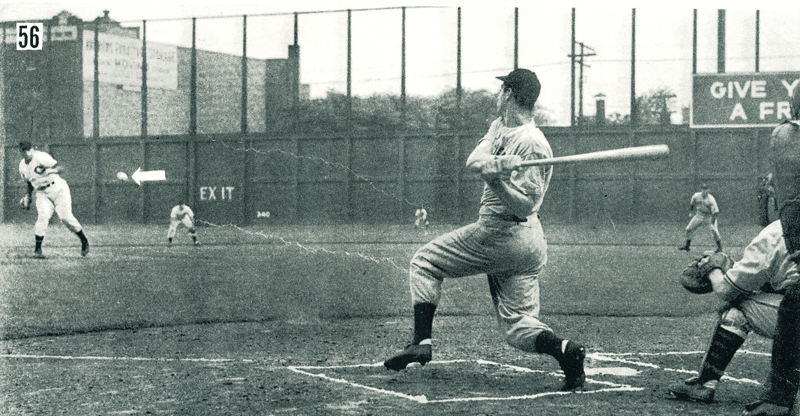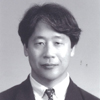Sports Research at the University of Tokyo
It is not just athletes who are seriously into sports at the University of Tokyo. In this section we introduce some of the "powerful Socrates" at the University, faculty members who are daily engaged in research and education relating to sports. Several sports researchers from among the many at the University of Tokyo describe the most interesting themes in sports research today.
Sports Sociology
Sports dreams and social processes
Heroes and “miraculous” moments

Fig. 1: The moment when Joe DiMaggio extends his hitting streak to 56 consecutive games. (The white arrow shows the batted ball flying into the middle field.) July 16, 1941, Cleveland. (Life, July 28, 1941)
Spectator sports, or in other words sports characterized by the presence of an audience at the matches, began to gain popularity in the second half of the 19th century. Such sports represent an experience in visualization of the existence of the crowd as an “audience.” This participation of the crowd in sports resulted in a situation in which spectator sports were loaded with mythical stories that served as a code to decipher connotations related to gender, social class, race, national or regional identity, and models of disciplinary training, or fantasies conveyed by social customs.
The popularity of sports, however, cannot be explained by such sharing of myths and fantasies alone. The very core of sports’ appeal contains fascinating moments of pure magic that open a void in the world of coded myths and dreams. The sports theater is a place that exposes spectators to a unique experience: to witness such miracles and come face to face with the living heroes who perform them.
The US Major League Baseball boasts the world’s highest annual attendance figures
Let’s examine the allegory of this experience from the perspective of US Major League Baseball (MLB). MLB represents only a fraction of US baseball, but its annual attendance figures are the highest in the world. In team sports, the MLB attendance figure is 3.3 - 4.3 times higher (more than 73 million people) than that of the second-placed leagues (Japan’s NPB, the US NHL, NBA, and NFL). The British football Premier League can be watched over almost all the world, yet its total attendance is less than a fifth of that of MLB.

Fig. 2: Babe Ruth and young George H. W. Bush: the Yale University baseball team uniform is similar to that of the New York Yankees. (Photo: public domain.)
There are two memorable photographs about the “hero” experience in MLB. One is of an aging, frail Babe Ruth presenting George H. W. Bush with his autobiography in 1948 (Figure 2). As a first baseman, Bush captained the Yale University baseball team and revered Babe Ruth as a hero. Ruth was MLB’s greatest legend, and his character blended tremendous, almost demonic power with childlike innocence. He died of cancer the same year, but in this photograph he is holding a cigarette in one hand and winking at Bush. "You know," he reportedly said. "In a story you can't put everything in, so I left a few things out." The hero charisma melted the young man’s tension and prompted him to smile.
DiMaggio’s “miracle,” or beyond the mythical world
The other photograph was published in Life magazine and depicts the moment when Joe DiMaggio extended his hitting streak to 56 consecutive games on July 16, 1941, the year of the attack on Pearl Harbor (Figure 1). His record is one of the treasures of MLB, and something extremely difficult to achieve from the perspective of probability theory. In fact, this is one very strange record, because, first, there is a pronounced discontinuity between the record and the second best achievement, and, second, there is a strong continuity between the second best achievement and numerous other records below it. That is probably what made many people suspect a conspiracy in the achievement of this record. According to these conspiracy theorists, the judgment of the entire American society, including the President, the Secretary of the Interior, the Commissioner of MLB, umpires, and baseball scorekeepers, was impacted by ulterior motives affecting calls on errors and hits, thus allowing DiMaggio to extend his hitting streak.
According to these conspiracy theories, back then the US President was looking for an opportunity to join the war against Germany, and hoped that DiMaggio would replace Charles Lindbergh, who opposed intervention in the war and appeared pro-German, as the American national hero of the times. It is impossible, however, to prove this, and unless the situation changes, the record in question will remain, not as a social construct, but rather as a phenomenon similar to a “hole” (a vanishing point), which cannot be controlled, in a social world constructed through social processes. In other words, DiMaggio’s record is a “miraculous” moment, in which the preexisting social reality (the place where myths are created) is nullified.
Sports sociology attempts to explain the myth-creation situations, in which people’s awareness and activities are entwined as they practice or appreciate sports. On the other hand, however, there are residual/blank spaces that cannot be explained simply with the social mythology effect. The excitement of sports is linked with the strange phenomenon we know as miracles. I believe that further research in this field will become another important theme of sports sociology.





